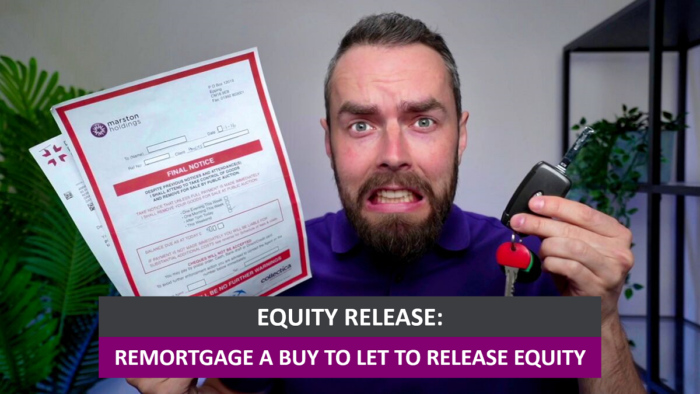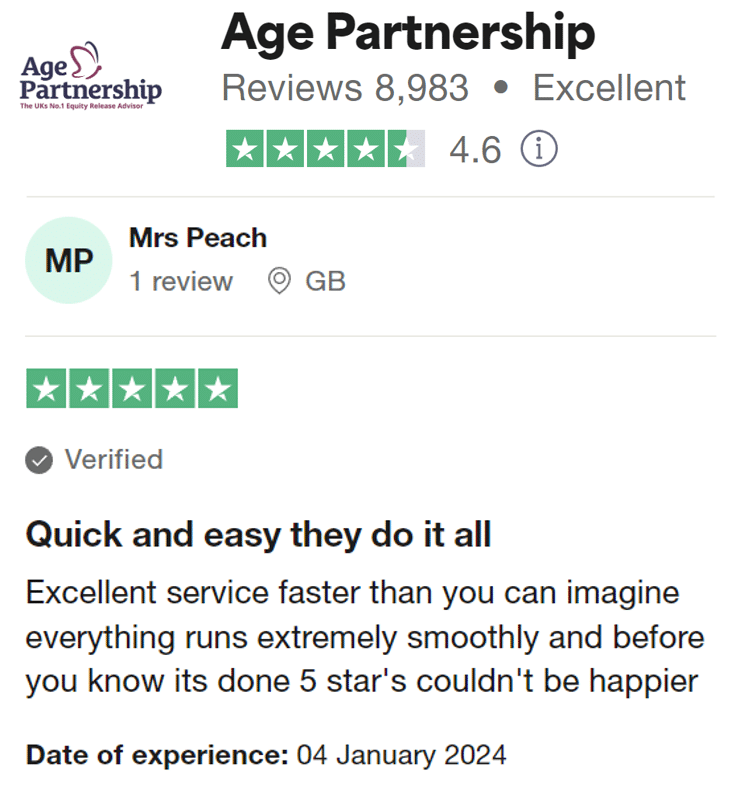Can you Remortgage a Buy to Let to Release Equity? Guide
Our preferred equity release adviser is Age Partnership. For free and impartial money advice you can visit MoneyHelper.

Our preferred equity release adviser is Age Partnership. For free and impartial money advice you can visit MoneyHelper.
“Are you keen to learn about remortgaging a buy to let to release equity? This guide will help answer all your questions and put your mind at ease. Every month, over 7,000 people find our guidance on equity release helpful.
In this article, we’ll cover:
- What remortgaging means.
- How remortgaging works on a buy to let property.
- How to get a realistic quote for remortgaging.
- The process of releasing equity.
- Different ways to release equity from a buy to let property.
We know that understanding equity release can be a bit difficult, but we’re here to help you. Our advice is easy to follow and will guide you through the whole process. We understand what it feels like to be unsure about financial decisions, and we’re here to make it all a bit easier.
So, if you’re ready to learn more about remortgaging a buy to let to release equity, let’s dive in!”
What is remortgaging?
Remortgaging is when a homeowner changes the first charge mortgage on their property. They swap their existing mortgage for a different mortgage deal, either with their current provider or a different one. The main reason for remortgaging is to secure a lower fixed interest rate for a set duration, saving the homeowner money on monthly interest payments.
When you remortgage, the money from the new mortgage is used to pay off the original mortgage deal. As the existing mortgage is being paid back earlier than agreed, it may trigger early repayment charges. Once you have remortgages, the same rules apply. You must keep up repayments on your mortgage or your home may be repossessed and sold to pay off the debt.
It’s common to remortgage a residential mortgage – i.e., the mortgage on the home you live in – but is it possible to remortgage on an investment property?
Your home’s equity is at risk
Equity release plans can be a great help. But, there are some bad deals out there. In fact, many people entering equity release plans may not be getting the most out of their home’s value.
To get an idea of what a good equity release deal could look like for you, try our free equity release calculator below. It took me less than 60 seconds!
Can it be done on an investment property?
Yes, it is possible to remortgage your investment properties as well as your main residence. If you have a buy to let mortgage on a property in the UK, you’ll be able to search for a better buy to let mortgage with other lenders and potentially switch to save money on interest payments or for other improved terms. You’ll only be able to remortgage to another buy to let mortgage if you intend to continue renting out the property to generate rental income.
How does it work?
Remortgaging from a buy-to-let mortgage to another buy-to-let mortgage works in the same way as you would switch residential mortgages. If you currently owe £100,000 on your existing mortgage, you’ll need to secure another appropriate mortgage deal of at least £100,000 to pay off your existing deal. You might need more to cover any fees, such as early repayment charges.
To remortgage, you might choose to engage with a mortgage adviser who will explain your options and search for mortgage lenders to find you suitable deals. If you decide to get mortgage advice, make sure the company you use is authorised and regulated by the Financial Conduct Authority.
What is releasing equity?
Releasing equity is accessing some of the monetary value in an asset, such as a house you own. To understand what releasing equity is in detail, you need to know how home equity is calculated.
Home equity is the value of the property that you own outright with no attached debt. It can be calculated by adding up all of the debts attached to your property and then subtracting this number from the up-to-date value of the property.
For example, most people only have one debt attached to their property, namely their first charge mortgage used to help purchase the property. Let’s imagine you bought a £200,000 home with a £50,000 deposit and took out a £150,000 mortgage. After so many years of repaying your mortgage, you pay off another £40,000 and during the same period, the value of the property increases by 10%.
You now own a £220,000 property with an outstanding mortgage balance of £110,000. In other words, you have 50% home equity, which in this case equals £110,000.
Releasing equity is using one of many methods to access some of this money as a cash lump sum or drawdown facility. You leverage the value in your asset to spend the money in other areas or for other investments.
If you’re struggling with working out how much equity release you could get from your home, you can use an equity release calculator. However I would recommend also speaking to your mortgage broker for professional advice going forward.
How equity release could help
More than 2 million people have used Age Partnership to release equity since 2004.
How your money is up to you, but here’s what their customers do…
Find out how much equity you could release by clicking the button below.
In partnership with Age Partnership.
Can you do it by remortgaging?
One of the most common ways to release equity is to remortgage. So, how do you remortgage to release equity?
It’s quite straightforward. As described earlier, remortgaging is switching your mortgage from one deal to another deal. To release equity at the same time, the homeowner asks to borrow more on the new mortgage, and this additional money is secured by the homeowner’s available home equity.
For example, if you want to remortgage a current mortgage of £70,000 and also have £60,000 equity in the property, the homeowner may ask for a new £100,000 mortgage. £70,000 of this amount is used to pay off the first mortgage and the remaining £30,000 is borrowed for another purpose, secured by the available home equity.
Are they the same?
Remortgaging is a method of equity release but it is not the same for two reasons:
- You can remortgage without releasing equity.
- You can release equity using other methods, which will be discussed at the end of our guide.
Can I possibly do both?
It is possible to remortgage buy to let mortgages and simultaneously release equity from the investment property. This simply works by swapping one buy to let mortgage for another one while also asking to borrow extra due to your available home equity.
Interestingly, if you own a number of rental properties, you may be able to remortgage to a portfolio mortgage where all repayments are made through one monthly repayment. When you get a portfolio mortgage, you can still release equity at the same time.
» TAKE ACTION NOW: Find out how much equity you could release
Can I use equity release?
If you already own one or more buy-to-let homes, you might be able to use equity release to free up some of the capital that you have locked up in those properties without having to sell any of them. As a result, your rental income continues to pour in, and you receive a tax-free lump sum to spend as you like.
Equity release and buy-to-let have slightly different restrictions when it comes to the percentage of your property that can be released. An equity release advisor can help you determine what’s possible for you and your real estate holdings.
Common reasons to do it
One of the most common reasons for releasing equity from an investment property is to either complete home improvements on the same property or to help buy another investment property.
If you were to use some of the equity to improve the property, the landlord could then increase the rent when appropriate. Moreover, the property may increase in value as a result of the renovations, and thus help secure a greater sale value in the future. Using some of the equity to help fund another property purchase is also common and a great way to expand a buy-to-let portfolio for long-term investments.
These are not the only reasons people decide to release equity from an investment flat or house. Others release equity for personal spending, to pay off debts and to renovate their own residence.
How much can I release?
You will not be able to borrow against all of your available equity because this creates a greater risk for you and the lender. On average, the highest percentage of equity you can take out is around 75% depending on the lender, your financial circumstances and your credit score.
You can often release between 20% and 60% of the property’s market value with lifetime mortgages. You have the option of releasing it all at once or in instalments.
This means if you have £50,000 home equity, you will only be allowed to take out around £37,000 equity in the best-case scenario.
Can I switch and release at the same time?
Some people may decide they want to start renting out the property they are currently living in. If they are switching from residents to landlords, they will need to switch from a residential mortgage to a buy to let mortgage.
This is a common scenario and should be a smooth process if you have built up enough home equity. You will need enough equity to do this because, on average, buy-to-let mortgages require a greater deposit than a residential mortgage. So switching early in your residential mortgage may not be possible without enough equity available.
If you want to release equity at the same time as switching from a residential to a buy-to-let mortgage, you’ll need to have even more home equity. Overall, it is possible, but you may not be able to release as much equity as if you were just switching residential mortgages.
Is it a good idea?
Remortgaging to release equity from any residential or investment property can be an effective way of accessing large amounts of cash at a competitive interest rate. It shouldn’t be done without good reason and intention to use the money, and it shouldn’t be done before receiving sound advice from an independent mortgage adviser.
Join thousands of others who release equity
Age Partnership have helped over 2 million people release equity from their home.

Mrs Wareham
“I am more than pleased to have taken out Equity Release with Age Partnership.”
Reviews shown are for Age Partnership. Search powered by Age Partnership.
Alternative Methods
As mentioned earlier, remortgaging can be a vehicle to release equity but it is not the only method available. Here are some alternative ways to release equity from an investment property.
#1: Second charge mortgages
A second charge mortgage is an overarching term that refers to different kinds of loans that are secured against some of the available equity in your property, such as home equity loans or home equity lines of credit (HELOC). These loans are secured by some of your available equity and are separate from your first mortgage, so you would need to make two separate monthly repayments to pay them off.
The benefit of choosing a second charge over remortgaging is that your initial mortgage stays active and you therefore incur no early repayment fees. On the flip side, your new loan may have closing costs and other fees attached, so you will want to consider all the fine details when considering both options.
#2: Lifetime mortgage equity release
Equity release – rather than “releasing equity” – refers to specific products that allow senior homeowners to release equity from the property they live in and own. The most common one is a lifetime mortgage. They require no repayments and the debt is only repaid after death or from the sale of their home if they move into long-term residential care.
The vast majority of equity release plans are not allowed on buy-to-let properties, but there are a very small number of lenders who may allow you to use a lifetime mortgage equity release plan on an investment property.
What happens if I’m declined?
Another option is secured loans. A secured loan might be an alternative to think about if you don’t want to remortgage or consider equity release (or you’re not eligible for either). Essentially, this is a second mortgage that is backed by the equity in your home.
Quick Recap!
It is possible to release equity by remortgaging on your buy-to-let mortgage. You may be able to access a cash lump sum of up to 75% of your home equity. But this will need to be repaid through monthly repayments. There may be other options to explore, such as a second charge mortgage on the investment property, and less so, a lifetime mortgage.
Things to consider
Equity release will involve a home reversion or a lifetime mortgage, which is secured against your property and will reduce the value of your estate and impact funding long-term care. Our equity release partner, Age Partnership provides a personalised illustration to explain the full details. The money you release, plus the accrued interest is then repaid when you die or move into long-term care. Advice is required before proceeding with equity release and any existing mortgage must be repaid. Age Partnership provide initial advice for free and without obligation. Only if your case completes would Age Partnership’s advice fee of £1,895 be payable. Other lender and solicitor fees may apply.


